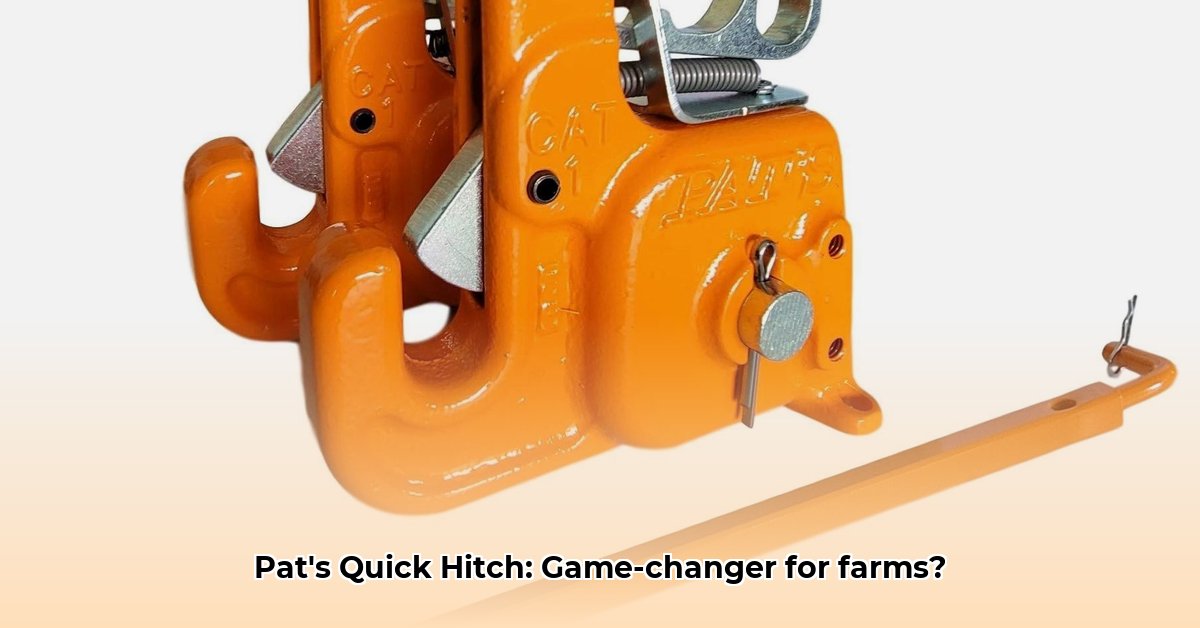
Pat's Quick Hitch Tractor Supply: A Detailed Review
Farming demands efficiency, and Pat's Quick Hitch systems promise to deliver. This in-depth review examines Pat's Quick Hitch's real-world performance, addressing ease of use, performance metrics, compatibility, cost, and safety, while acknowledging critical information gaps. The goal is to equip farmers with the information needed to make informed purchasing decisions. For example, check out this Ford 3000 loader information for related equipment.
Ease of Use: Streamlining Implement Changes
Pat's Quick Hitch aims to simplify tractor implement changes. The advertised "No lifting—let Pat's do the heavy work" suggests a user-friendly design. The process generally involves three steps:
- Alignment: Carefully position the implement onto the quick hitch.
- Engagement: Secure the implement using the locking mechanism (typically a latch or lever).
- Completion: Detaching follows a similar, straightforward process.
Numerous farmer testimonials highlight the system's ease of use and reduced physical strain. However, a short learning curve might be necessary for some users. Does this system truly live up to its promise of effortless implement changes? While anecdotal evidence is positive, standardized testing would provide more compelling data.
Performance: The Critical Need for Quantifiable Data
While many farmers report increased workflow efficiency with Pat's Quick Hitch, concrete performance data remains scarce. This lack of readily available information significantly hinders a comprehensive evaluation. The absence of published benchmarks makes it difficult to objectively assess the system's speed and overall impact on farm operations. To address this, Pat's should commission independent testing to quantify attachment/detachment times, durability, and long-term impact on farm operations.
Farmers can contribute valuable data through self-assessment. By tracking implement change times—both with and without the quick hitch—farmers can generate their own performance benchmarks. Such self-evaluation provides valuable, real-world insights. What are your key performance indicators (KPIs) when selecting farming equipment?
Compatibility: Addressing Implement and PTO Concerns
Pat's Quick Hitch boasts compatibility with implements of "all widths." However, further details are needed on adapting non-quick hitch compatible implements. While adaptation methods likely exist, their effectiveness and practical limitations require clarification. Similarly, data on Power Take-Off (PTO) compatibility is currently unavailable. Before purchasing, farmers should directly contact Pat's for comprehensive compatibility information. Will this system truly work seamlessly with your existing equipment and workflows?
Comparing Pat's Quick Hitch to Competitors: A Data-Driven Approach
A complete comparison with competitors is challenging due to limited available data. However, critical areas for comparison include price, durability, features, and total cost of ownership. Detailed specifications and independent testing are crucial for a meaningful analysis. What are the key differentiators between Pat's Quick Hitch and leading competitors in the market?
Total Cost of Ownership: A Long-Term Perspective
Beyond the initial purchase price, consider long-term costs such as maintenance, repairs, and potential downtime. Will the time saved using this system offset potential additional costs? Analyzing lifespan and overall operational costs is essential for a thorough assessment. What factors beyond the sticker price directly impact your total cost of ownership? Knowing this helps you to calculate your return on investment.
Safety: Prioritizing Farmer Well-being
Detailed safety information from Pat's is crucial. Understanding the system's built-in safety features and compliance with relevant safety standards is paramount. Farmer safety should always be the top priority. What measures are in place to ensure safe and reliable operation of Pat's Quick Hitch for users?
Key Takeaways: Making Informed Decisions
- Limited Data: The lack of publicly available performance data hinders objective evaluation.
- Ease of Use: Anecdotal evidence suggests ease of use, but rigorous testing is needed.
- Compatibility: Clarification is needed regarding compatibility with all implements and PTO systems.
- Cost: Consider long-term costs, including maintenance and repairs, not just the initial investment.
- Safety: Detailed safety information and regulatory compliance data is crucial.
Farmers considering Pat's Quick Hitch should actively seek comprehensive data from Pat's regarding performance, compatibility, and safety. Until this information gap is filled, independent testing and self-evaluation by farmers remain crucial for informed decision-making.